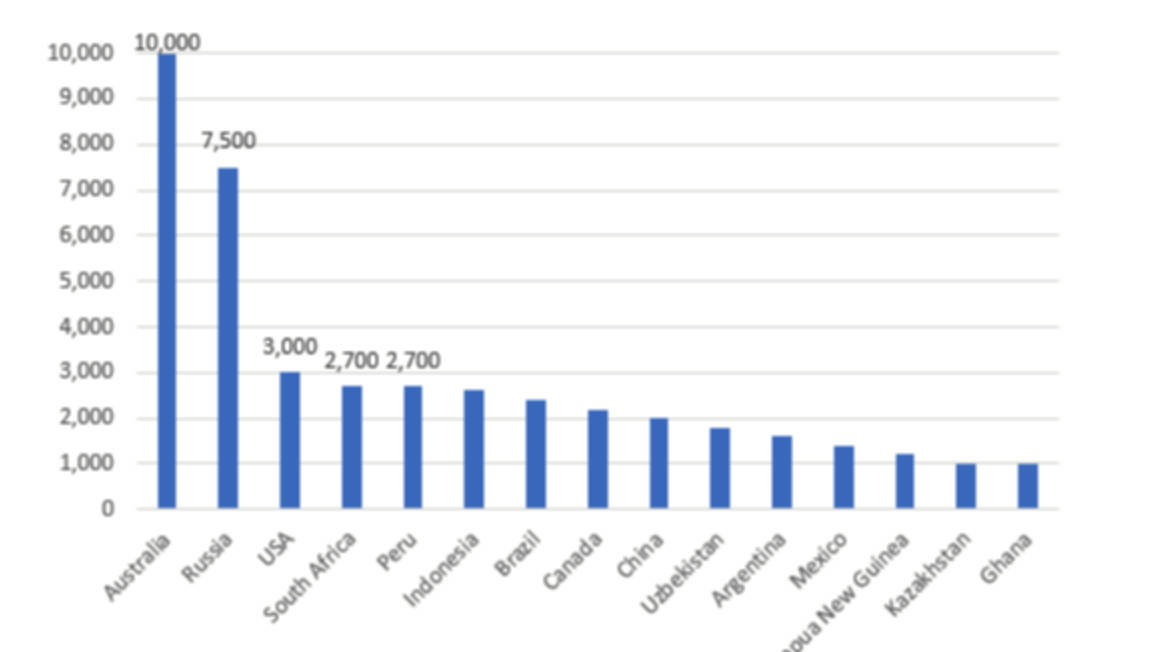Gold facing strong headwinds from rising US bond yields and crypto price

Picture: Getty Images
- Gold price in uphill struggle against headwinds of higher US bond yields, equities, bitcoin
- ‘Higher Treasury yields raise the opportunity cost of holding bullion’
- ASX Gold Stocks Guide: Everything you need to know
Gold remains off its early January peak of $US1,950 per ounce ($2,530/ounce) as yields on US Treasury bonds creep higher and alternative investment assets such as cryptocurrencies increase their appeal as a store of value.
Yellow metal prices were trading around $US1,832 per ounce ($2,376/ounce) in Tuesday trade, up from a market low of $US1,795 per ounce last week.
The 10-year US Treasury bond was trading with a yield of 1.18 per cent Tuesday and has been climbing since hitting a record low of 0.5 per cent back in August.
“Higher Treasury yields raise the opportunity cost of holding bullion, exerting downward pressure on its safe haven appeal,” reported Arslan Butt at FX Leaders.
Interest on US Treasury bonds has risen as the US government presses ahead with a new $US1.9 trillion spending package to relieve the economic effects of COVID-19.
“The associated fears of US dollar debasement, in addition to negative real rates policy, should eventually see gold rally from the lows,” TD Securities said in a note.
Indian import tax cut to boost gold demand by 13 tonnes in 2021
Physical demand in two important gold markets, China and India, appears robust, with Chinese consumers buying gold ahead of mid-February’s Lunar New Year holiday.
Chinese consumers took delivery of 159.5 tonnes of gold from the Shanghai Gold Exchange in January, up 44 per cent on 110.8 tonnes in January 2020, said bullion company Sharps Pixley.
Indian gold demand is expected to be boosted by an Indian government decision to reduce import taxes on the yellow metal and silver to 7.5 per cent from 12.5 per cent from February 1, said the Singapore Bullion Market Association.
“The long-term impact of this lower import duty is just an increase in demand of 7 tonnes, while the short-term impact is an increase in demand of 13 tonnes in 2021,” said Mukesh Kumar of the World Gold Council’s Market Intelligence Group.
Gold exchange-traded funds received inflows equivalent to 13.8 tonnes worth $US1bn in January, after experiencing net outflows in November and December, according to World Gold Council data.
Crypto buying trims price gains for gold
Bitcoin and other cryptocurrencies may be attracting some investment flows that would have otherwise gone to gold, said analysts.
“The Bitcoin craze does seem to have detracted from funds that would ordinarily have gone to the gold market,” David Rosenberg, chief economist and strategist at Rosenberg Research told The Daily Hodl, a cryptocurrency news service.
Rosenberg estimates that Bitcoin has siphoned off about 10 per cent of gold’s potential price gains, or about $US200 per ounce.
Bitcoin surged this week with the announcement that Tesla chief Elon Musk had purchased $US1.5 billion ($1.94bn) of Bitcoin in January.
The EV maker said in its latest filing to the US Securities and Exchange Commission that it had bought Bitcoin to diversify and maximise its returns on its cash holdings.
Tesla added that it expected to start accepting the cryptocurrency as form of payment for sales of its EVs.
Bitcoin surged to a new record of $US46,000 ($59,685) Tuesday after the announcement from Tesla, after having undergone a 20 per cent price correction in January.

Antipa Minerals reports hits for Rio Tinto joint venture
The share price of gold explorer Antipa Minerals (ASX:AZY) edged higher Tuesday as it reported assay results for its Calibre deposit in WA’s Paterson gold province.
Drilling results show significant widths of gold, copper and silver mineralisation were intersected, including substantial high-grade gold mineralisation outside Calibre’s boundary.
Hits for Calibre, which is 45km east of Rio Tinto’s (ASX:RIO) Winu copper-gold-silver deposit, include 14m at 1.28 grams per tonne gold and 0.03 per cent copper.
Calibre is part of Antipa Minerals’ Citadel joint venture which has an exploration budget of $13.8m and the program is managed by its project partner Rio Tinto Exploration.
Rio Tinto continues to advance development studies for its Winu deposit from which first ore is expected in 2024.
Lachlan Fold Belt project discovery boosts Devex Resources
Devex Resources (ASX:DEV) gained around 10 per cent in Tuesday ASX trade on announcing an extensive 1km long copper-gold soil anomaly for its Junee project in NSW.
The project lies on the southern extension of the Macquarie Arc, Australia’s largest porphyry copper-gold terrane, and is within the Lachlan Fold Belt of NSW.
The copper-gold anomaly remains open to the south and west in the project’s Nangus Road prospect, and is supported by other elements including, molybdenum, bismuth and tellurium.
The Junee project lies between the NSW towns of Gundagai and Wagga Wagga, and the Lachlan Fold Belt is host to Alkane Resources’ (ASX:ALK) famous Boda prospect.
Miramar Resources announces exploration licence for Whaleshark
WA-focused explorer Miramar Resources (ASX:M2R) has been granted an exploration licence for its Whaleshark gold project near the WA coastal town of Onslow.
The project is characterised by a large folded banded iron formation and buried under 100m of sediments from the northern Carnarvon basin.
Previous exploration activity intersected anomalous gold in a sulphidised banded iron formation with results of up to 1.7m at 0.73 grams per tonne gold.
The explorer said it believed the project has significant unrealised potential for the discovery of BIF-hosted gold and has identified a number of key drilling targets.
Miramar Resources intends to carry out geochemical sampling and examine options for further electromagnetic surveys of Whaleshark.
The company joined the ASX in October on an $8m IPO, and has several exploration projects in the Eastern Goldfields, Murchison and Gascoyne regions of WA.
ASX share prices for Antipa Minerals (ASX:AZY), Alkane Resources (ASX:ALK), Devex Resources (ASX:DEV), Miramar Resources (ASX:M2R)

UNLOCK INSIGHTS
Discover the untold stories of emerging ASX stocks.
Daily news and expert analysis, it's free to subscribe.
By proceeding, you confirm you understand that we handle personal information in accordance with our Privacy Policy.








